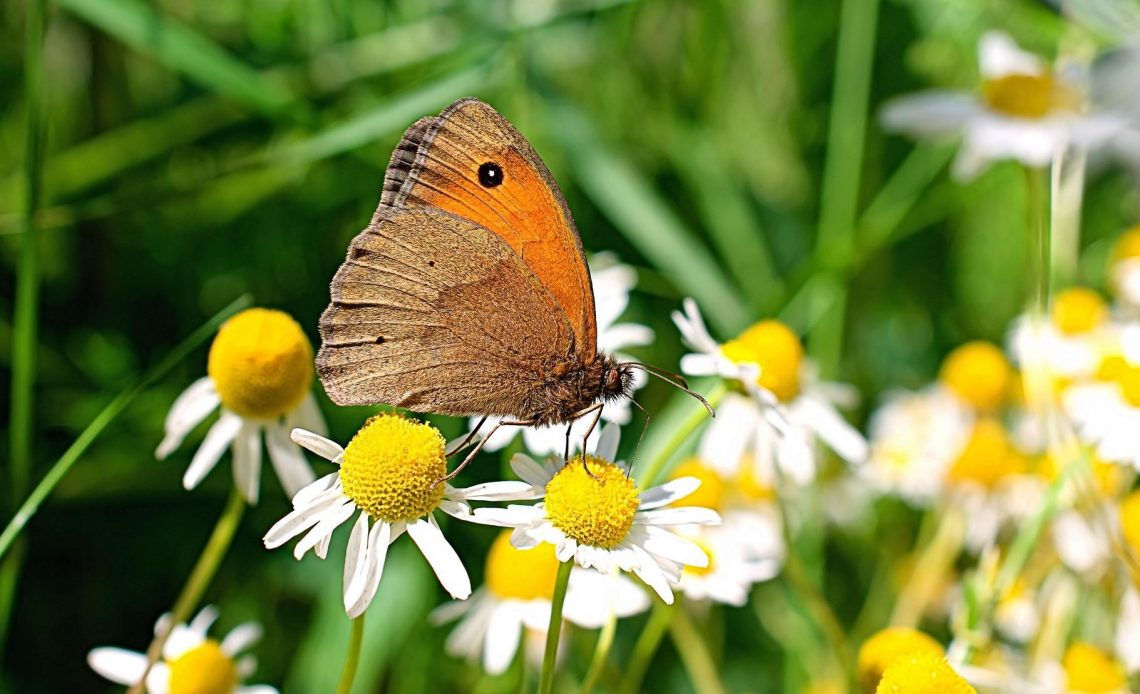

We’re here to help! Wild Yards is a completely free website that is 100% dedicated to helping you create a wildlife-friendly, sustainable yard. Read more
WildYards is reader-supported. When you buy a product through a link on our site, we may earn a comission. Every product is independently selected by our (obsessive) editors and our reviews are unbiased and objective. Read more about our mission or our privacy policy.
Flowers and butterflies seem to go hand in hand, and when it comes to daisies, we’re always likely to see a few fluttering around. That said, these little creatures also have specific tastes and preferences. Do butterflies like daisies?
Butterflies love daisies. They will always welcome pollinators because of their bright colors, rich nectar content, and blooming periods. Daisies are also some of the easiest flowers to grow and, when well-maintained, will keep butterflies coming to your garden year after year.
Why do daisies attract butterflies?
Daisies are some of the brightest blooms in the garden, making them easy for butterflies to spot. Butterflies tend to prefer reds, oranges, and yellows above all other hues. Daisies are also full of easy-to-reach nectar, even when other flowers are not yet in bloom or have died off for the season. Butterflies see them as highly reliable food sources as a result.
Daisies are also surprisingly complex – they give off so much nectar as they consist of multiple different flowers and buds. Daisy centers, for example, are made up of hundreds of tiny yellow disc flowers – it’s here where butterflies will find much of the nectar they’re hungry for, and the pollen they will disperse across your garden.
Meanwhile, white ray flowers are the petal shapes surrounding the yellow centers. Butterflies will use ray flowers to rest on, giving them easy access to the nectar within the disc flowers. As butterflies can’t feed on nectar in mid-air, having platforms to sit on while feeding is highly sought-after.
Some types of daisy – such as the cosmos flower – even attract specific butterfly species. This particular type of daisy is a Mexican border plant and is known to welcome the highly-prized monarch butterfly, for example.
Do butterflies like Shasta daisies?
Butterflies are not fickle when it comes to daisies, making the widespread Shasta variety a prime pick. These perennials bloom during the summer and boast beautiful green leaves throughout the year. While the leaves aren’t of as much importance to the butterflies, they will help to keep your garden thriving all year long! As evergreens, daisies provide food and shelter for insects when other essential plants have died off for the season.
These plants are also highly obvious to pollinators. Shasta daisies can grow to a few feet tall and boast plenty of beautiful heads of around three inches wide. Each head has a nectar-filled center, which is the perfect shade of yellow to attract butterflies.
They usually spring up in groups, too, making them ideal for pollinators – there is plenty of nectar to go around!
How to grow daisies to attract butterflies to your garden
If you plan to grow daisies from seeds, then plant them directly in the ground in the spring. Wait for the final frost to pass before planting them so that the cold does not affect the seeds. Around the springtime, you’ll often start seeing butterflies emerging in your garden, so this procedure is perfectly timed.
Daisies need plenty of sunlight, and so do their seeds! Ideally, pick a nice sunny spot with sun throughout most of the day. To ensure that the sun will touch the seeds, only cover them with about an eighth of an inch of soil. The soil will need to be well-drained and very nutritious! Ideally, mixing it with peat moss and even manure will help your daisies grow stronger.
Conveniently, butterflies will typically only head to flowers that grow in full sun. Like sunflowers, daisies are open, love the heat, and are extremely obvious to any passing pollinators and other insects.
Your seeds will need about 10 to 20 days to germinate properly, during which time they will need plenty of water. Keep the soil moist, but do not let it get too wet. Remember that the seeds will be in full sun all day, so try to water them every evening.
Once the flowers have started blooming, you will be happy to know that they will not need nearly as much care! You can sit back and wait for crowds of butterflies to flutter across and feed.
By deadheading your daisies multiple times across the year, you will see multiple flowers rebloom. Daisies can bloom up to three times during one season – which, as you’d expect, means more butterfly visitors.
At the end of the season, when the daisies have no more to give, cut them down to the leaves. That way, the plant is more likely to regrow the following year.
What flowers do butterflies like the most?
Alongside daisies, butterflies love a variety of bright-colored, nectar-filled flowers such as sunflowers, zinnias, marigolds, lilacs, lantanas, and snapdragons.
Butterflies prefer flat, open flowers that are easy to eat from. Providing you grow a variety of different blooms that follow these rules, you are always likely to welcome a varied crowd of insects. Butterflies, like us, prefer a varied diet – so don’t be too quick to fill your yard with daisies alone.
Are daisies the best flowers for attracting butterflies?
No one or two flowers are ‘best’ at attracting butterflies, but daisies are reliable and well-liked by most pollinators. Thankfully, they are also straightforward to propagate, meaning a well-tended garden should keep butterfly populations fluttering back from season to season.
Why not mix in daisies with sunflowers and snapdragons – and see which species of butterfly you welcome next?
